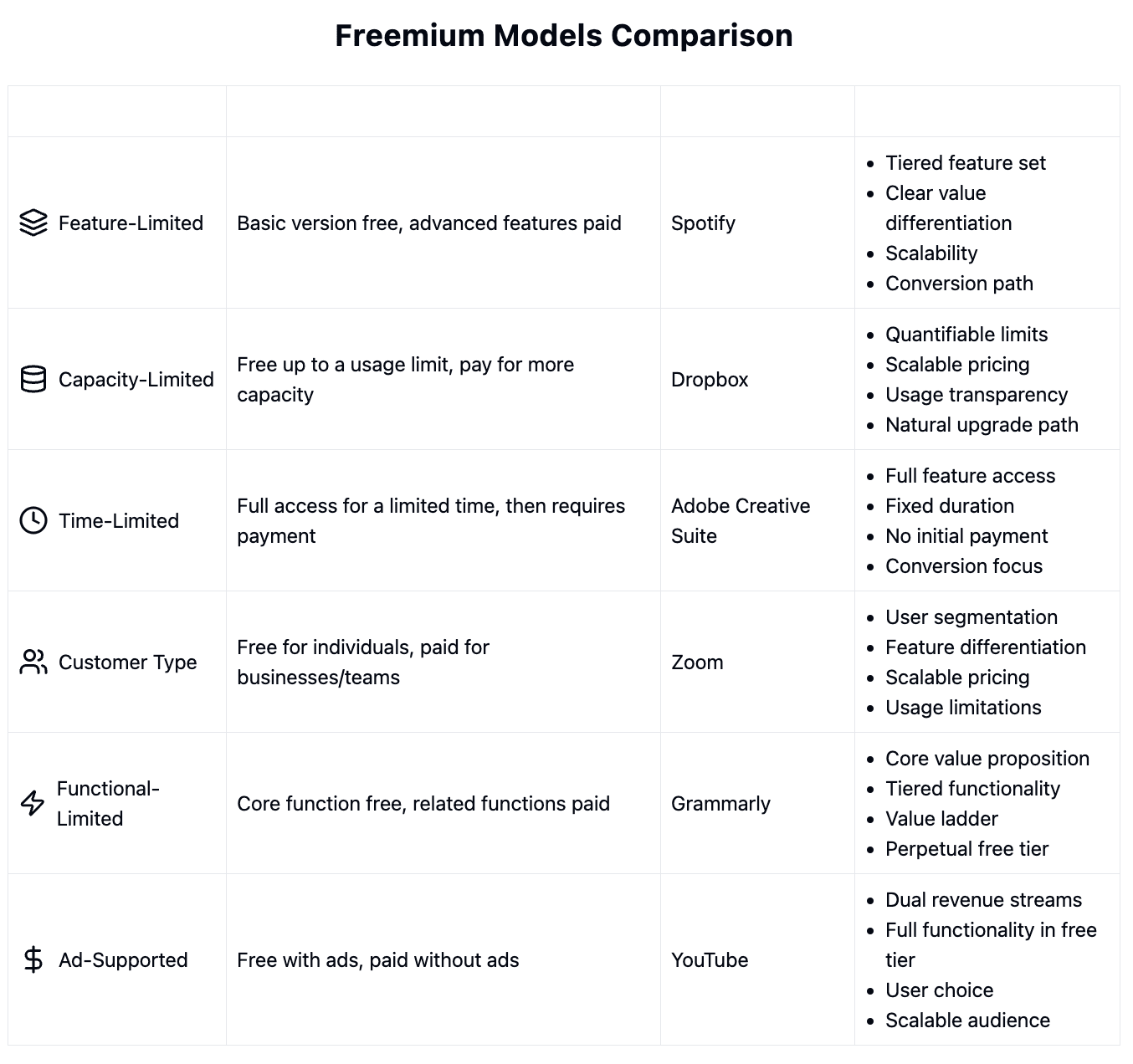
Freemium Models in SaaS: A Comprehensive Guide

by
Wiktoria Slowikowska
Oct 14, 2024
Identify and convert your most valuable users
Sign Up
Software companies are constantly seeking innovative ways to acquire, retain, and monetize users. Two strategies that have gained significant traction are Product-Led Growth (PLG) and freemium models. When combined, these approaches create a powerful framework for scaling software businesses. This comprehensive guide explores the intersection of freemium models and PLG, providing insights into their implementation, benefits, challenges, and best practices.
Understanding Product-Led Growth (PLG)
Product-Led Growth is a business methodology in which user acquisition, expansion, conversion, and retention are primarily driven by the product itself. Unlike traditional sales-led growth models, PLG relies on the product to do much of the "selling" through its inherent value and user experience.
Key characteristics of PLG include:
Focus on end-user experience
Self-serve onboarding
Rapid time-to-value
Viral loop mechanisms
Data-driven product iterations
PLG has gained popularity due to its ability to scale efficiently and its alignment with modern user preferences for trying before buying.
What Are Freemium Models?
Freemium is a pricing strategy that offers a basic version of a product or service for free while charging for premium features, functionality, or services. This model is particularly prevalent in software-as-a-service (SaaS) and mobile applications.
The term "freemium" is a portmanteau of "free" and "premium," encapsulating the dual nature of the offering. Freemium models aim to attract a large user base with the free offering and then convert a portion of these users to paying customers.
Types of Freemium Models
There are several types of freemium models, each with its own strengths and applications:
1. Feature-Limited Freemium
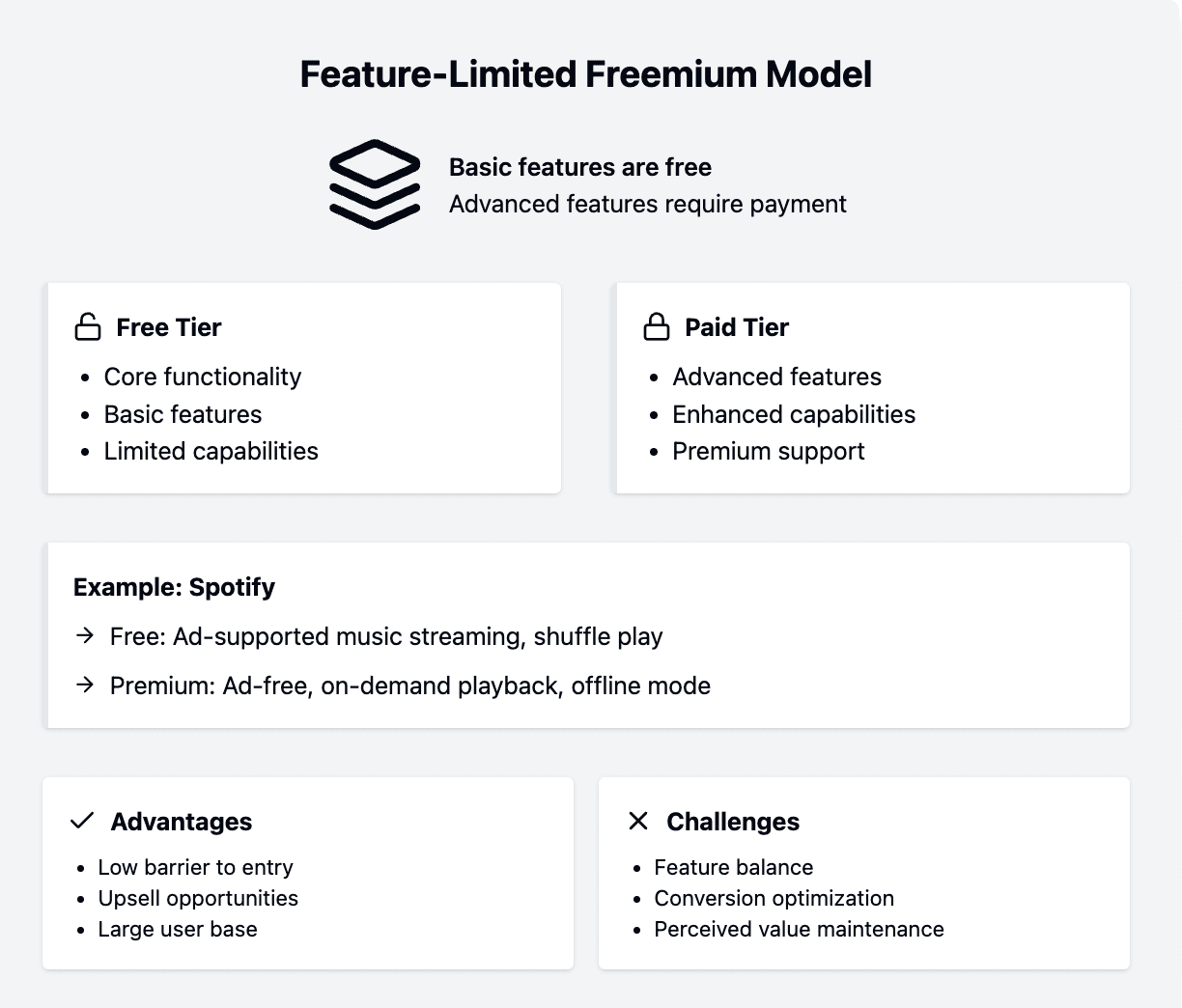
Feature-Limited Freemium is a business model where a company offers a basic version of its product or service for free, while charging for advanced or premium features. This model aims to attract a large user base with the free offering and then convert a portion of these users to paying customers by enticing them with additional functionality.
Key Characteristics
Tiered Feature Set:
Free Tier: Offers core functionality that provides genuine value to users.
Paid Tier(s): Includes advanced features, enhanced capabilities, or removal of limitations.
Clear Value Differentiation:
The premium features must offer significant additional value to justify the cost.
Scalability:
The free version should be able to support a large user base without incurring prohibitive costs.
Conversion Path:
There should be a clear and easy path for users to upgrade from free to paid tiers.
Example - Spotify:
Free Tier: Ad-supported music streaming, shuffle play on mobile, limited skips.
Premium Tier: Ad-free listening, unlimited skips, offline mode, higher quality audio.
Strategy: The free tier introduces users to the vast library and personalized playlists, while premium features enhance the listening experience.
2. Capacity-Limited Freemium
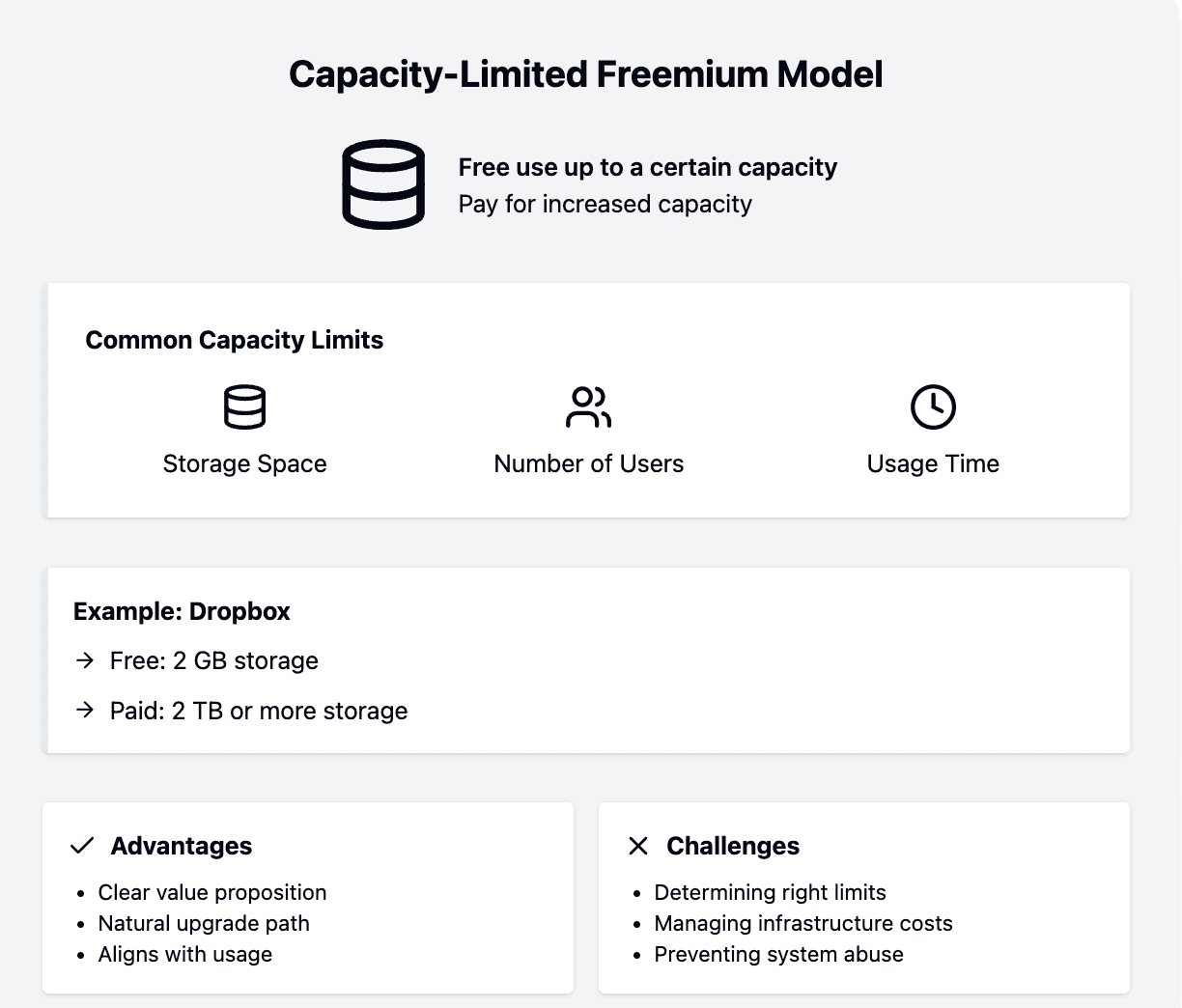
Capacity-Limited Freemium is a business model where a company offers its product or service for free up to a certain usage limit or capacity threshold. Once users reach this limit, they must upgrade to a paid plan to continue using the service or to access additional capacity. This model is particularly common in cloud storage, communication tools, and software-as-a-service (SaaS) applications.
Key Characteristics
Quantifiable Limits:
The free tier has clearly defined and measurable usage limits (e.g., storage space, number of users, API calls).
Scalable Pricing:
Paid tiers often offer incremental increases in capacity, allowing users to choose a plan that fits their needs.
Usage Transparency:
Users can easily track their usage and see how close they are to the free tier limits.
Natural Upgrade Path:
As users engage more with the product, they naturally approach the capacity limits, creating organic upgrade opportunities.
Value Retention:
The core functionality of the product remains the same across tiers; only the usage capacity changes.
Cost Alignment:
The model often aligns well with the company's cost structure, especially for services where costs scale with usage.
Freemium Longevity:
Users can remain on the free tier indefinitely as long as they stay within the capacity limits.
Tiered Offerings:
Multiple paid tiers with different capacity limits cater to various user segments (e.g., individual, small business, enterprise).
Example - Dropbox:
Dropbox is a prime example of a Capacity-Limited Freemium model in the cloud storage and file synchronization market.
Free Tier:
Dropbox Basic offers 2 GB of free storage space.
Users can increase this to up to 16 GB through referrals (500 MB per referral).
Paid Tiers:
Dropbox Plus: 2 TB of storage
Dropbox Professional: 3 TB of storage
Dropbox Business: Starts at 5 TB, scales to unlimited storage for larger teams
3. Time-Limited Freemium (Free Trial)
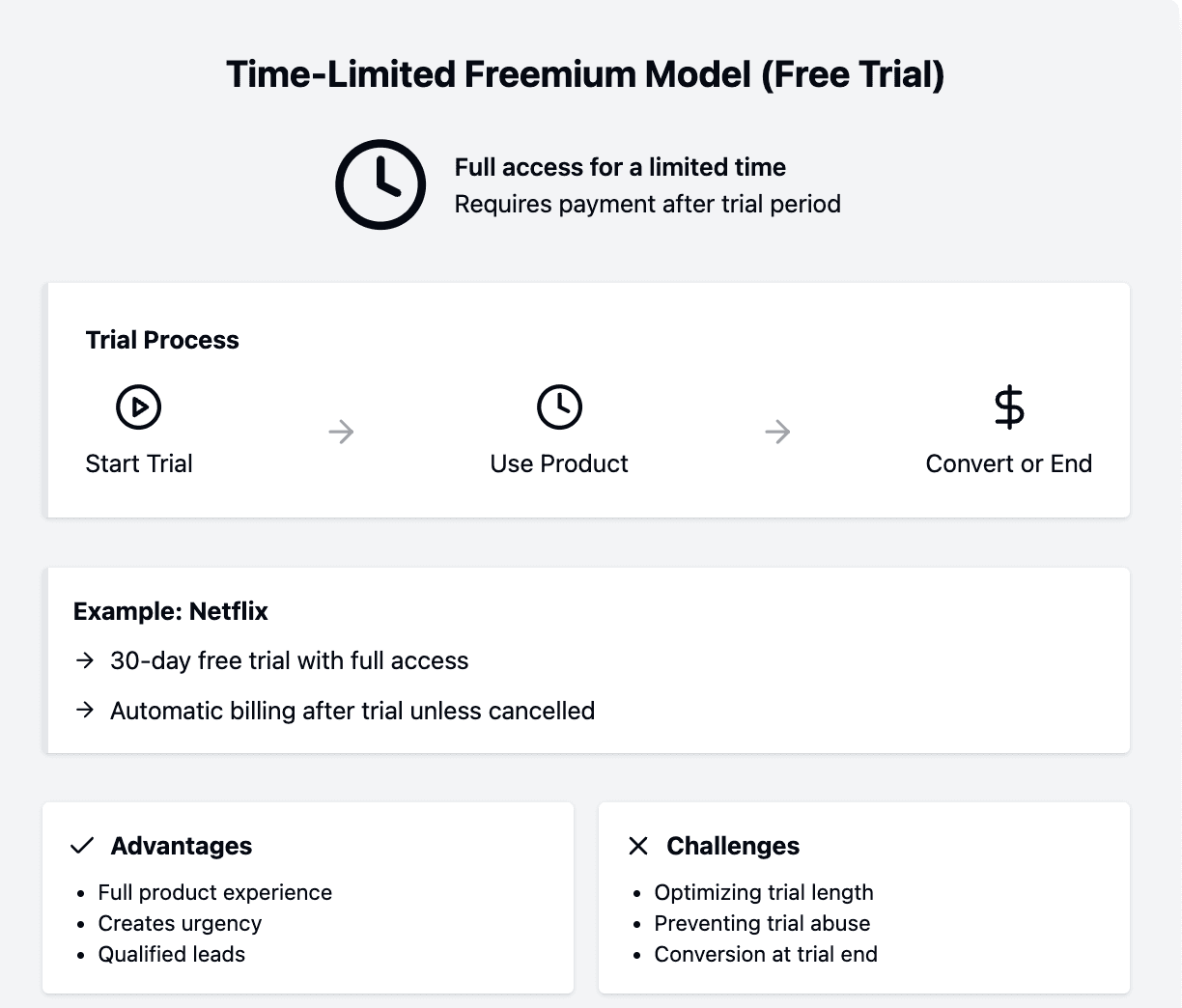
Time-Limited Freemium, often referred to as a Free Trial, is a business model where users are given full access to a product or service for a limited period, after which they must pay to continue using it. This model allows potential customers to experience the full value of the product before making a purchase decision.
Key Characteristics
Full Feature Access:
Users typically get access to all features during the trial period.
Fixed Duration:
The trial period is clearly defined, often ranging from a few days to a month.
No Initial Payment:
Users can start the trial without providing payment information in some cases.
Conversion Focus:
Strong emphasis on converting trial users to paying customers before the trial ends.
Automated Transition:
Often includes an automatic transition to a paid plan unless the user cancels.
Example - Adobe Creative Suite:
Trial Offering: 7-day free trial of the entire suite or individual applications.
Implementation:
Requires creating an Adobe account.
Limited to one trial per product per user.
Strategy: Gives professional users a chance to test the software's capabilities in their workflow before committing to a subscription.
4. Customer Type Freemium
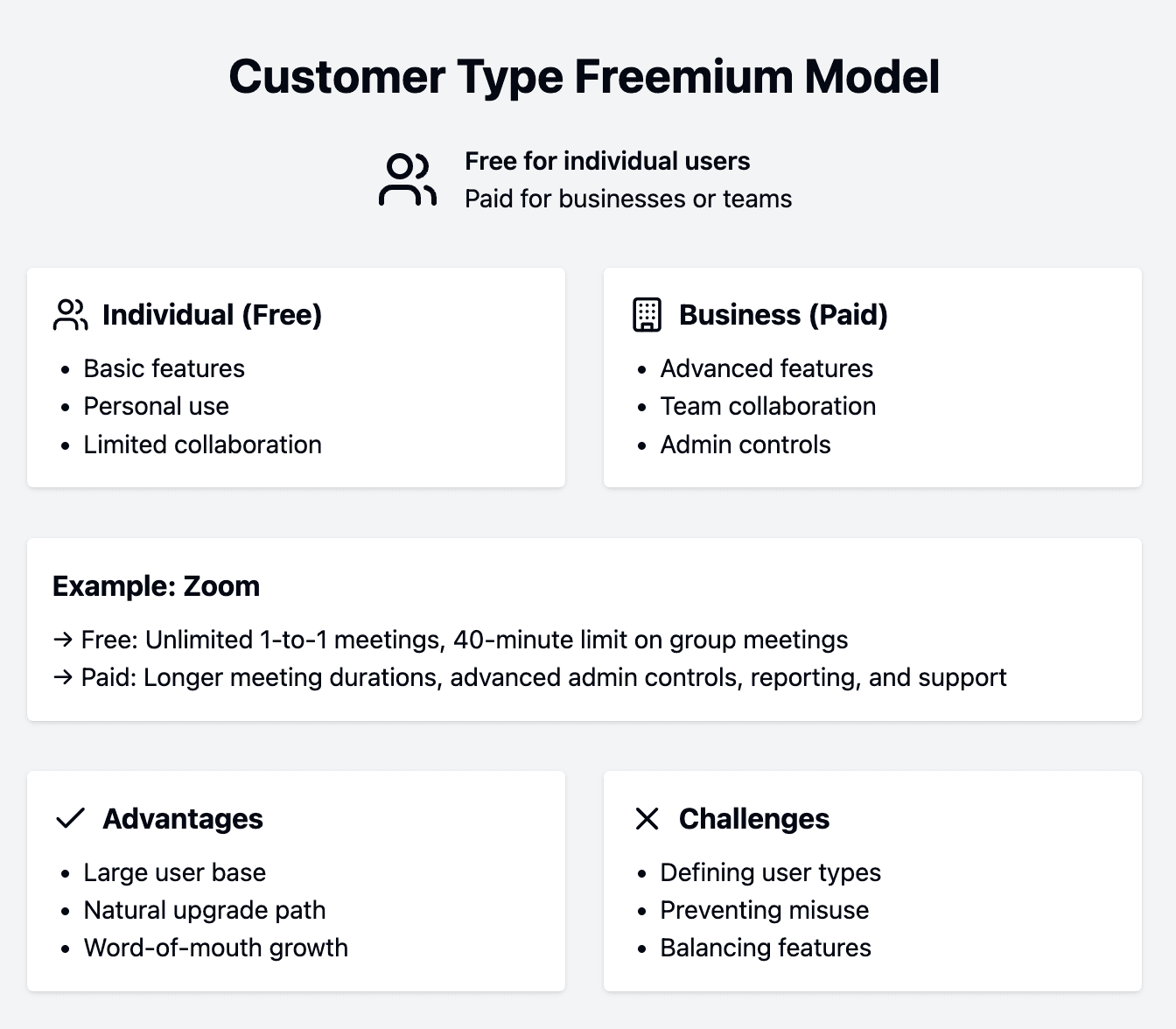
Customer Type Freemium is a business model where a company offers its product or service for free to individual users or for specific use cases, while charging for business or team use. This model aims to build a large user base among individuals while monetizing professional or commercial usage.
Key Characteristics
User Segmentation:
Clear distinction between individual and business/team users.
Feature Differentiation:
Business plans often include additional features tailored for professional use.
Scalable Pricing:
Paid plans typically scale based on team size or usage intensity.
Usage Limitations:
Free plans may have certain restrictions that don't apply to paid business plans.
Conversion Path:
Natural upgrade path as individual users transition to professional or team use.
Example - Zoom:
Free Tier: Unlimited 1-to-1 meetings, 40-minute limit on group meetings.
Paid Tiers: Pro, Business, and Enterprise plans with longer meeting durations and additional features.
Implementation:
Free for personal use with basic features.
Paid plans for businesses with advanced admin controls, reporting, and support.
Strategy: Allows individuals to use the platform freely, driving adoption, while businesses pay for necessary features and longer meeting times.
5. Functional-Limited Freemium
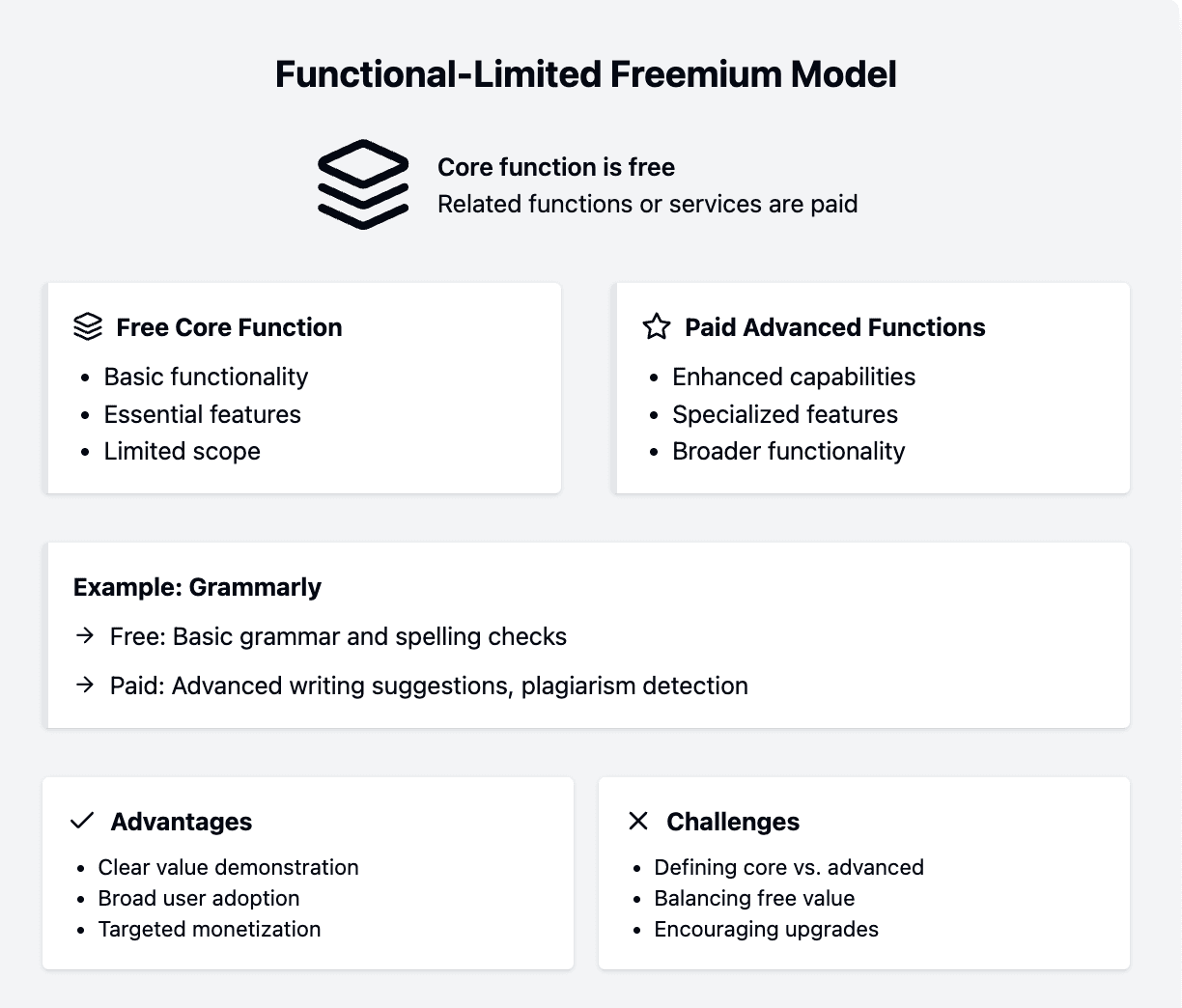
Functional-Limited Freemium is a business model where the core function of a product or service is offered for free, while related functions, advanced features, or additional services require payment. This model aims to provide users with a valuable base product while monetizing enhanced functionality or specialized use cases.
Key Characteristics
Core Value Proposition:
The free version offers the primary functionality that defines the product.
Tiered Functionality:
Additional features or services are available in paid tiers.
Value Ladder:
A clear progression of value from free to various paid levels.
User Segmentation:
Different tiers often cater to varying user needs or skill levels.
Perpetual Free Tier:
Users can continue using the core functionality indefinitely without payment.
Example - Grammarly:
Free Tier: Basic grammar and spelling checks.
Paid Tiers: Premium features including advanced grammar checks, style suggestions, plagiarism detection, and tone adjustments.
Implementation:
Free browser extension and basic web app for core functionality.
Premium subscription for advanced features and integrations.
Strategy:
Provides essential writing assistance to all users, building a large user base.
Upsells to premium features for users who need more comprehensive writing support.
Ad-Supported Freemium Model

Ad-Supported Freemium is a business model where users can access the core product or service for free with the inclusion of advertisements, while a paid version offers an ad-free experience and potentially additional features. This model monetizes the free user base through ad revenue while offering an upgrade path for users who prefer an uninterrupted experience.
Key Characteristics
Dual Revenue Streams:
Generates income from both ad impressions and premium subscriptions.
Full Functionality in Free Tier:
Core features are typically available in the ad-supported version.
User Choice:
Allows users to decide between viewing ads or paying for an ad-free experience.
Scalable Audience:
Potential for a large user base attractive to advertisers.
Tiered Offering:
Often includes additional perks in the paid tier beyond ad removal.
Example - YouTube:
Free Tier: Ad-supported access to all user-generated content and most original content.
Paid Tier (YouTube Premium): Ad-free viewing, background play, offline downloads, and access to YouTube Originals.
Implementation:
Ads are integrated into the viewing experience (pre-roll, mid-roll, banner ads).
Premium subscription removes ads and adds extra features.
Strategy:
Maintains a vast, free user base attractive to advertisers.
Offers enhanced experience for users willing to pay, including exclusive content.
Opt-In vs. Opt-Out Freemium
Another important distinction in freemium models is between opt-in and opt-out approaches:
Opt-In Freemium
Description: Users start with the free version and must actively choose to upgrade to the premium version. Examples: Most traditional freemium models (Dropbox, Spotify free tier)
Pros:
Lower barrier to entry for new users
Users feel in control of their decision to upgrade
Cons:
May result in lower conversion rates
Requires strong value proposition to motivate upgrades
Opt-Out Freemium
Description: Users start with full premium features for a trial period and must actively choose to downgrade to the free version or cancel. Examples: Netflix free trial, Adobe Creative Suite trial
Pros:
Higher initial conversion rates
Users experience full product value immediately
Cons:May lead to higher churn if users forget to cancel
Can be perceived as aggressive or manipulative if not implemented thoughtfully
The choice between opt-in and opt-out models can significantly impact user acquisition, conversion rates, and overall user experience. Companies must carefully consider their target audience, product complexity, and value proposition when choosing between these approaches.
In a product-led growth strategy:
Opt-in models often work well for products with a clear, easy-to-understand value proposition that users can grasp quickly.
Opt-out models can be effective for more complex products that require time to fully appreciate, or for products with strong brand recognition and perceived value.
It's worth noting that some companies use a hybrid approach, offering an opt-in freemium model for their basic product and an opt-out trial for premium features or enterprise versions. This strategy allows them to cater to different user segments and use cases within the same product ecosystem.
Advantages and Challenges of Freemium Models
Let's explore the key advantages and challenges that businesses face when adopting a freemium model:
Advantages of Freemium Models
Low barrier to entry for new users: Allows users to try the product without financial commitment, increasing adoption rates.
Viral growth potential: Free users can easily share and recommend the product, leading to organic growth.
Large user base for feedback and product improvement: A broad user base provides valuable insights for iterative development and feature prioritization.
Upsell opportunities: Free users are already familiar with the product, making them prime candidates for premium upgrades.
Competitive advantage in crowded markets: Free offerings can help a product stand out and gain market share in competitive industries.
Challenges of Freemium Models
Balancing free and premium features: Determining which features to offer for free versus paid is crucial for both user acquisition and monetization.
Converting free users to paying customers: Encouraging users to upgrade requires clear value proposition and effective marketing strategies.
Supporting a large non-paying user base: Managing infrastructure and support costs for free users can be challenging without compromising service quality.
Potential for cannibalization of paid offerings: If free features are too generous, they may reduce the incentive for users to upgrade to paid plans.
Maintaining perceived value of premium features: Continuously innovating and enhancing paid features is necessary to justify the cost to users.
By carefully considering these advantages and challenges, businesses can develop more effective freemium strategies that balance user acquisition, engagement, and monetization. The key to success lies in creating a value proposition that attracts users with the free offering while providing clear incentives for upgrading to premium services.
Implementing Freemium in PLG Strategies
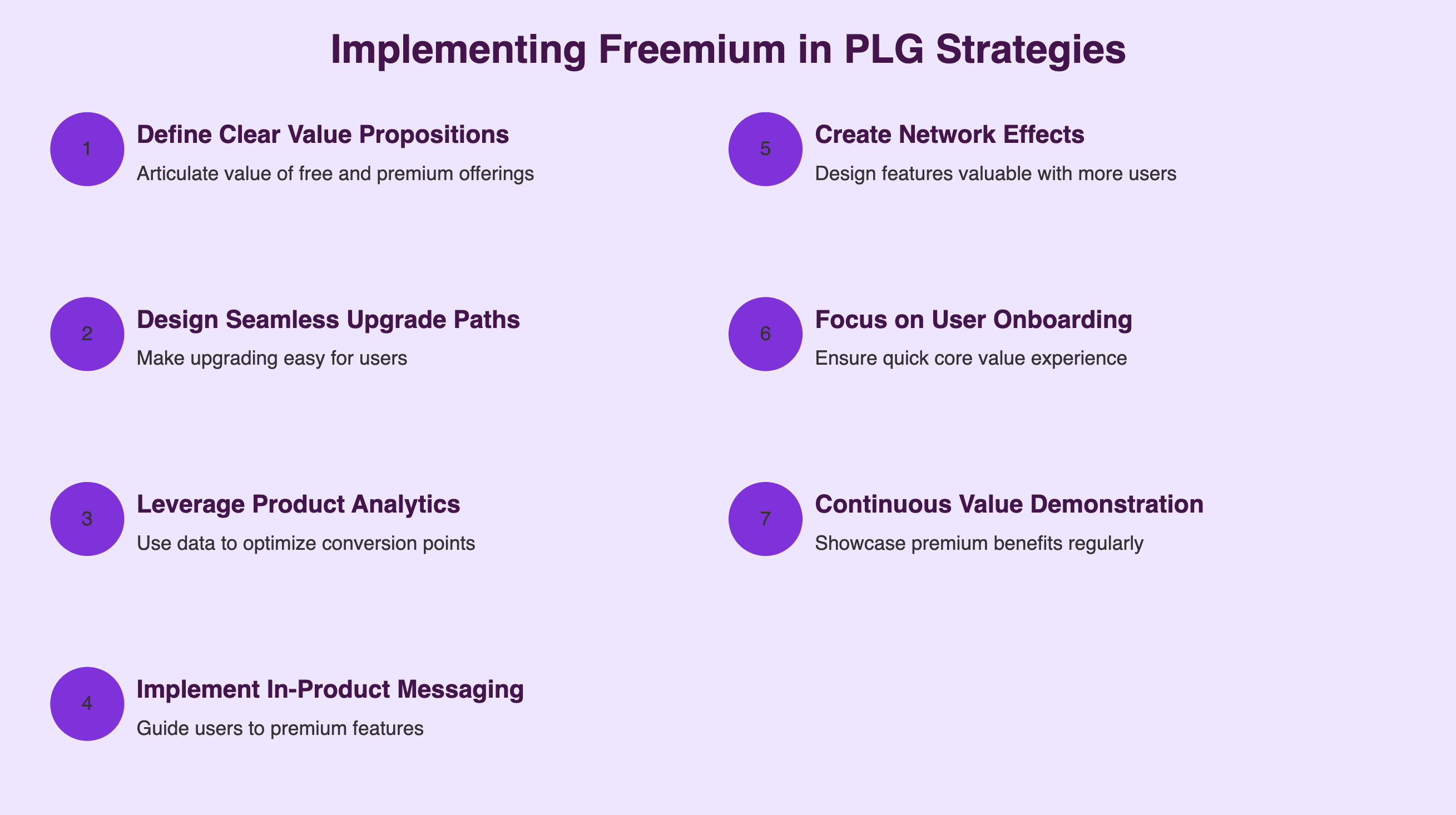
Integrating freemium models into a PLG strategy requires careful planning and execution:
Define Clear Value Propositions: Clearly articulate the value of both free and premium offerings.
Design Seamless Upgrade Paths: Make it easy for users to upgrade when they're ready.
Leverage Product Analytics: Use data to understand user behavior and optimize conversion points.
Implement In-Product Messaging: Guide users towards premium features at relevant moments.
Create Network Effects: Design features that become more valuable as more users join.
Focus on User Onboarding: Ensure new users quickly experience the product's core value.
Continuous Value Demonstration: Regularly showcase the benefits of premium features to free users.
Measuring Success in Freemium PLG
Key metrics for evaluating freemium PLG success include:
Conversion Rate: Percentage of free users who upgrade to paid plans
Time to Conversion: Average time it takes for a free user to become a paying customer
Customer Acquisition Cost (CAC): Cost of acquiring a new customer
Lifetime Value (LTV): Predicted net profit from the entire future relationship with a customer
Retention Rate: Percentage of users who continue using the product over time
Net Promoter Score (NPS): Measure of customer satisfaction and loyalty
Feature Adoption Rate: Percentage of users engaging with specific features
Viral Coefficient: Number of new users an existing user generates
Conclusion
Freemium models, when effectively integrated with Product-Led Growth strategies, offer a powerful approach for software companies to scale their user base and drive sustainable growth. By providing value upfront, these models align with modern user expectations and create opportunities for organic expansion.
However, success with freemium PLG requires careful balance, continuous optimization, and a deep understanding of user behavior and needs. Companies must navigate the challenges of converting free users, managing costs, and maintaining a compelling value proposition for premium offerings.
As the digital landscape continues to evolve, freemium PLG strategies will likely adapt, incorporating new technologies and responding to changing user preferences. Companies that can effectively leverage these models, while remaining agile and user-focused, will be well-positioned to thrive in the competitive software market.
By embracing the principles of Product-Led Growth and thoughtfully implementing freemium models, businesses can create a virtuous cycle of user acquisition, engagement, and monetization, driving long-term success in the digital economy.
